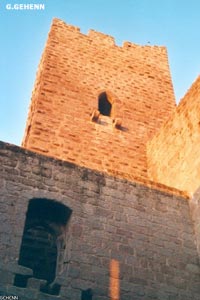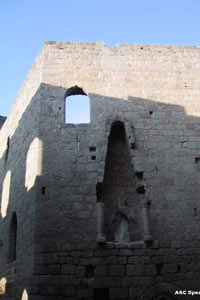|
History of the castle
 Built
over a granitic headland in rothmannsberg, with 451 m of altitude,
Spesbourg dominates the valley of Andlau. The majority of the historians
of the castle appoint 1246-1250 like dates of construction and E
Hering allots it to Alexandre de Stahleck-Dicka then acknowledged
of the abbey of Andlau. Built
over a granitic headland in rothmannsberg, with 451 m of altitude,
Spesbourg dominates the valley of Andlau. The majority of the historians
of the castle appoint 1246-1250 like dates of construction and E
Hering allots it to Alexandre de Stahleck-Dicka then acknowledged
of the abbey of Andlau.
It is however advisable
to notice that the first formal mention of the castle goes back
only to 1322 by instituting Henri de Stahleck-Dicka in the capacity
as lord of Spesbourg.
The family of Dicka is not originating in Alsace. Since XIIème
century, it provides dignitaries to the churches cathedrals in the
high one and average valley of the Rhine. Henri de Stahleck-Dicka
is an initially canon of Mainz before acquiring this dignity in
Strasbourg in 1238. On this date, the interests in Alsace of the
Stahleck-Dicka family are neither territorial, nor patrimonial.
With the accession with the episcopal see, the list of the privileges
for the family lengthens considerably, from alliances are concluded
with Landsberg, Windstein, the counts de Werde...
It is in this context that Henri de Stahleck-Dicka inféode
his Alexandre brother of the right of avouery on the abbey of Andlau.
Alexandre is quoted several times in the episcopal charters between
1255 and 1259, and it is in March 1258 that it is seen transferring
to his son and life the office from Burgrave which it occupies.
We are in the medium of XIIIème century and in impossibility
of saying if at that time of Dicka constituted a land seigniory
in the area of Andlau because their titles of goods date all from
XIVème century.
1353 : the emperor Charles IV assistant of Gauthier
de Dicka, hereditary solicitor of the abbey, the vidame Rodolphe
d' Andlau like Pierre and Henri d'Andlau by stipulating that Gauthier
is authorized to transmit his rights and strongholds in Andlau if
he would die without male offspring.
1383 : Gauthier institutes the lords d' Andlau
like successors in Spesbourg.
1386 : Gauthier dies in Switzerland with the battle
of Sempach and does not leave a heir. The castle is used then as
residence to members of the family of Andlau but nothing comes to
corroborate unspecified installations in order to adapt the openings
for the use of the weapons with fire as it was the case in many
Alsatian castles at the XVe century...
 1431
: Etienne of Bavaria invests Spesbourg which was without
defenders. The same year the castle is taken again by of Andlau
to the head of 2000 men 1431
: Etienne of Bavaria invests Spesbourg which was without
defenders. The same year the castle is taken again by of Andlau
to the head of 2000 men
XVIe century : the castle does not remain uninhabited;
the Hering historian teaches us that Spesbourg is attacked and set
fire to by middle-class men of Barr because noble would have suborned
one of their fellow-countrywoman.
Nothing in the documents attests of a rebuilding but elements which
cannot be former to XVIe (stars painted in the niches, dates 1550
on the cast-iron plate from a chimney) indicate rehandlings. After
the great revolution the building is seen tearing off its more beautiful
stones and was used as career to the inhabitants of the surroundings.
1830/40 : The counts d' Andlau are given in possession
of their property and sell the ruin to the baron of Hallez empire.
About 1890 the widow of the baron sells the building to Dr. Alexis
Stoltz.
1904 : Alexis Stoltz bequeaths Spesbourg by will
to L the town of Andlau.
1964-65 : operations Mole with various consolidations
and excavations.
1967 : Spesbourg is classified Historic building.
1985 : Creation of Association for the Restoration
of the Castle of Spesbourg Sections of work, animations, son et
lumière displays.
Bibliography
Charles-Laurent SALCH , Le Château de Spesbourg, architecture
et histoire, Chantiers d'Etudes Médiévales, n°14,
1977 |




 Built
over a granitic headland in rothmannsberg, with 451 m of altitude,
Spesbourg dominates the valley of Andlau. The majority of the historians
of the castle appoint 1246-1250 like dates of construction and E
Hering allots it to Alexandre de Stahleck-Dicka then acknowledged
of the abbey of Andlau.
Built
over a granitic headland in rothmannsberg, with 451 m of altitude,
Spesbourg dominates the valley of Andlau. The majority of the historians
of the castle appoint 1246-1250 like dates of construction and E
Hering allots it to Alexandre de Stahleck-Dicka then acknowledged
of the abbey of Andlau. 1431
: Etienne of Bavaria invests Spesbourg which was without
defenders. The same year the castle is taken again by of Andlau
to the head of 2000 men
1431
: Etienne of Bavaria invests Spesbourg which was without
defenders. The same year the castle is taken again by of Andlau
to the head of 2000 men
